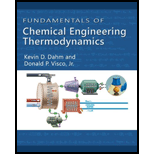
(A)
Interpretation:
The heat added to the system.
Concept Introduction:
The steady state energy balance equation for piston cylinder device.
Here, mass flow rate for inlet and outlet is
(B)
Interpretation:
The heat added to the system.
Concept Introduction:
Here, the change in enthalpy is determined by adding the amount of heat needed to heat the ice, amount of heat needed to change the phase, and the amount of heat needed to heat the new fluid up to
Then the Equation (3) becomes.
(C)
Interpretation:
The heat added to the system.
Concept Introduction:
Here, all the solids need to dissolve and be raised to allocate the proper temperature, and only a quarter of the aggregate fluid is changed over into vapor, the ̇ condition is broken into the fluid and the vapor segments.
Then the Equation (3) becomes.
(D)
Interpretation:
The heat added to the system.
Concept Introduction:
Here, all of the solid turns into a vapor before the process to end, then the procedure is demonstrated in five stages: heat added to the solid, melting, heating the liquid, boiling and heating vapor.
Then the Equation (3) becomes.
Want to see the full answer?
Check out a sample textbook solution
Chapter 3 Solutions
Fundamentals of Chemical Engineering Thermodynamics (MindTap Course List)
 Introduction to Chemical Engineering Thermodynami...Chemical EngineeringISBN:9781259696527Author:J.M. Smith Termodinamica en ingenieria quimica, Hendrick C Van Ness, Michael Abbott, Mark SwihartPublisher:McGraw-Hill Education
Introduction to Chemical Engineering Thermodynami...Chemical EngineeringISBN:9781259696527Author:J.M. Smith Termodinamica en ingenieria quimica, Hendrick C Van Ness, Michael Abbott, Mark SwihartPublisher:McGraw-Hill Education Elementary Principles of Chemical Processes, Bind...Chemical EngineeringISBN:9781118431221Author:Richard M. Felder, Ronald W. Rousseau, Lisa G. BullardPublisher:WILEY
Elementary Principles of Chemical Processes, Bind...Chemical EngineeringISBN:9781118431221Author:Richard M. Felder, Ronald W. Rousseau, Lisa G. BullardPublisher:WILEY Elements of Chemical Reaction Engineering (5th Ed...Chemical EngineeringISBN:9780133887518Author:H. Scott FoglerPublisher:Prentice Hall
Elements of Chemical Reaction Engineering (5th Ed...Chemical EngineeringISBN:9780133887518Author:H. Scott FoglerPublisher:Prentice Hall
 Industrial Plastics: Theory and ApplicationsChemical EngineeringISBN:9781285061238Author:Lokensgard, ErikPublisher:Delmar Cengage Learning
Industrial Plastics: Theory and ApplicationsChemical EngineeringISBN:9781285061238Author:Lokensgard, ErikPublisher:Delmar Cengage Learning Unit Operations of Chemical EngineeringChemical EngineeringISBN:9780072848236Author:Warren McCabe, Julian C. Smith, Peter HarriottPublisher:McGraw-Hill Companies, The
Unit Operations of Chemical EngineeringChemical EngineeringISBN:9780072848236Author:Warren McCabe, Julian C. Smith, Peter HarriottPublisher:McGraw-Hill Companies, The





